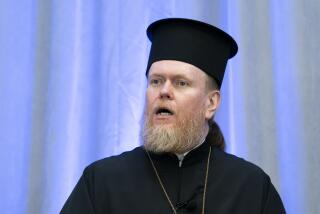Prelate Expresses Hope for Soviet Armenia : Karekin II Begins Monthlong Visit to Southland
- Share via
LOS ANGELES — The spiritual leader of about 150,000 Armenians living in Southern California, beginning a monthlong visit to the region that will include the consecration Sunday of a Santa Ana church, expressed hope Friday that the Soviet government, “in the context of true perestroika,” will recognize the claims of Soviet Armenia to a disputed territory.
And although His Holiness Karekin II, spiritual leader of the Cilician branch of the Armenian Apostolic Church, was not aware of it when interviewed here Friday morning, the prospect that the Soviet leadership in Moscow would have an opportunity to grapple with the difficult issue seemed to have grown Friday. The parliament of the southern Soviet republic of Azerbaijan rejected a request by residents of the disputed region of Nagorno-Karabakh that the region be transferred to neighboring Armenia. (Story in Part I, Page 4.)
The vast majority of residents of Nagorno-Karabakh are Christians, but the majority in the controlling region of Azerbaijan is Muslim.
Commenting about the opportunity that the dispute presents to the Kremlin, the pontiff said, “In this era of perestroika (a social and economic restructuring under way in the Soviet Union) , this would be tangible proof” that the Soviets are committed to “human rights and rights of the people.”
The dispute, which has flared into violence and which a leading Soviet spokesman has described as having grown into a constitutional “collision,” is over nationality, not religion, said Karekin II, who is based in Lebanon and who serves the stateless Armenians in diaspora. His official title is Catholicos of the Great House of Cilicia.
It is estimated that there are 300,000 Armenians living in Southern California, most in Los Angeles County, about half of whom are believed to belong to Karekin II’s jurisdiction, the See of Cilicia.
That jurisdiction claims eight California parishes, including the 2-year-old Forty Martyrs Church in Santa Ana .
During his visit, the pontiff will consecrate two churches built since his last official visit in 1984. He will perform Holy Mass and consecration at 10:30 a.m. Sunday at the Forty Martyrs, and at St. Mary’s in Glendale on July 10.
On Thursday night, an estimated 6,000 Armenians packed the Avedissian Hall in Glendale to hear Karekin II. “For two hours, people were coming to him to kiss his ring, to touch him, to be blessed,” said Berdj Karapetian, a spokesman for Karekin’s visit.
Because Armenians have had no autonomous state since 1920, the church and its leaders symbolize a homeland as well as religion, Karapetian said.
On Friday night, Gov. George Deukmejian, an Episcopalian of Armenian descent, was scheduled to attend a $5,000-a-couple dinner at the Beverly Hills Hotel with the pontiff and 125 other Armenian couples. The banquet was to benefit the Armenian General Athletic Union.
Oxford-educated Karekin II, 56, said he came to California “under the sign of togetherness,” referring to past tensions between the two Armenian Apostolic Church jurisdictions: the See of Cilicia and the See of Etchmiadzin, based in Soviet Armenia and led by Patriarch Vazken I.
The See of Etchmiadzin claims about 20 parishes in California.
So far, no representatives from the other jurisdiction have called to make an appointment, he said.
“I am open to see them anytime they would like to come and meet me,” he said.
Karekin II said that he and Vazken I have great respect for each other and he called the leader in Soviet Armenia the “primacy of honor,” or the first among equals. But in any future unification, Karekin II would not relinquish his jurisdiction, according to sources close to the Catholicos.
Neither Vazken I nor the Roman Catholic church recognizes the See of Cilicia, according to Krikor Haleblian, who teaches Armenian studies at Fuller Theological Seminary in Pasadena. “It’s controversial. They started this catholicate in the assumption that communism was detrimental and they would be politically maneuvered to give orders not consistent with the welfare of the Armenian church in the diaspora.” During Pope John Paul II’s visit to California, it was the Etchmiadzin bishop, not the Cilician bishop, who was invited to ceremonies, Haleblian said.
Karekin II described growing religious freedoms in the Soviet Union, where he recently attended ceremonies celebrating the millennium of Christianity.
He said Christians can be seen waiting in line to baptize their children, the number of seminary students is growing, and a theological course for women is being offered in the atheistic state. Religious marriages are also increasing, he said.
In Soviet Armenia, four churches--closed during the Stalinist era--have been reopened in recent months, although all churches in the Nagorno-Karabakh region remain closed, he said.
Dressed in a simple robe of royal blue, he displayed artifacts of Orthodox iconography which he said were manufactured at a factory center outside Moscow. The center also makes vestments, crosses and candles.
Contrary to common belief, his jurisdiction is not anti-Soviet, he said.
“I believe glasnost and perestroika are like daily bread for the people,” he said. “I believe the wisdom of (Soviet General Secretary Mikhail S.) Gorbachev consists in having seen the validity of the aspirations and in responding to the aspirations.”
It is difficult to be “100% sure” that the new openness and social and economic restructuring, including religious freedoms, are real, he said.
But he added: “I was deeply impressed with the intensity of spiritual life of the Russian church.”
He is scheduled to make more than 40 appearances during his stay in Southern California before traveling to San Francisco.
More to Read
Sign up for Essential California
The most important California stories and recommendations in your inbox every morning.
You may occasionally receive promotional content from the Los Angeles Times.













